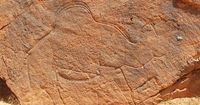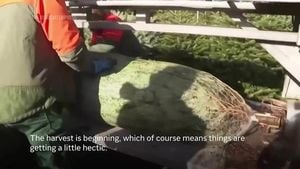High on the sandstone cliffs of northern Saudi Arabia, a remarkable gallery of ancient art has emerged from the desert’s silence. Archaeologists have documented 62 monumental rock art panels, featuring 176 engravings—most of them life-sized camels—etched up to 39 meters (128 feet) above the ground. These carvings, found in the Sahout region, are not only breathtaking in scale and artistry but also offer tantalizing clues about the people who created them nearly 12,000 years ago, during one of the harshest climate periods in human history.
According to Nature Communications, the engravings were carved between 12,800 and 11,400 years ago, a time when the Arabian Peninsula was emerging from the Last Glacial Maximum. The climate then was unforgiving: only temporary, unpredictable lakes appeared after rare rains, and the landscape was dominated by arid plains and shifting dunes. Yet, hunter-gatherer communities not only survived but thrived, leaving behind these monumental artworks as evidence of their ingenuity and adaptability.
What sets these carvings apart is not just their size or age, but their strategic placement. The panels are located near the edges of ancient lake beds and along natural travel corridors. At sites like Jebel Misma, every engraving flanks a former lake, while at Jebel Arnaan, the animal figures follow a gully where water still briefly pools after infrequent rains. The researchers suggest that these locations were chosen deliberately, possibly to serve as landmarks for wayfinding between ephemeral water sources. As the study’s authors explain in Nature Communications, “Depictions of wild animals and the marking of natural landscapes may have been a mechanism to mark routes and perhaps also served as territorial markers documenting access rights via impressive images.”
Creating these artworks was no easy feat. Many panels required artists to perch on narrow, downward-sloping ledges—some only 30 to 50 centimeters (12 to 20 inches) wide—high above the desert floor. The sandstone is now too degraded for modern researchers to reach these heights safely, underscoring the risks the ancient artists must have faced. As the research team notes, “The friable nature of the substrate and the slope of the narrow ledges suggest the engravers likely risked their lives to create this art.”
The artistry itself is extraordinary. The engravings were made using wedge-shaped stones, which allowed the artists to produce sharp, detailed lines. “To engrave that much detail with just a rock takes real skill,” said Maria Guagnin, an archaeologist at the Max Planck Institute of Geoanthropology in Germany, who co-authored the study. Some carvings stand over six feet (1.8 meters) tall, and the largest panel stretches 23 meters (75 feet) across two cliff surfaces. The creators had to work at arm’s length, unable to step back and view their progress, making the precision of their work all the more impressive.
The subject matter of the art provides further insight into the lives and environment of these ancient communities. Camels dominate the scene, making up 72% of the engravings, followed by ibex (12%), wild horses (10%), and gazelles (5%). There is also a single depiction of an auroch—a large, now-extinct wild ancestor of cattle that never inhabited the desert. This unusual inclusion has led researchers to speculate that the artists may have traveled to greener regions during dry seasons or were familiar with distant landscapes. “They must have been fully established communities that knew the landscape really well,” Guagnin observed, as reported by Agency News.
Archaeological excavations beneath the panels unearthed occupation layers dating from the same period as the carvings. Stone tools, pigments, and marine shell beads found at the sites reveal long-distance connections with Levantine communities, located over 320 kilometers (200 miles) away. Notably, El Khiam arrowheads—typical of early farming groups in Israel and Palestine—were discovered, along with marine shells likely sourced from the Mediterranean or Red Sea. These finds point to regular cross-desert travel and trade, even in such a forbidding environment. As the study notes, “The artefact assemblages include Levantine stone tool types and decorative forms of material culture, suggesting regular and repeated cultural contact across long distances.”
The artistic tradition itself appears to have evolved over thousands of years. Researchers identified four distinct phases: early carvings feature small, stylized human figures; later ones depict large, naturalistic animals with unique characteristics; and the most recent phases show more standardized, cartoon-like images. This progression may reflect changing functions—from detailed representations encoding specific information to more symbolic markers serving broader cultural or territorial purposes.
Dating such ancient engravings is notoriously difficult, especially in the absence of written records or organic materials like charcoal. The breakthrough in this case came when scientists discovered a rock pick—used as a carving tool—directly beneath one of the panels. This allowed them to date both the tool and the artwork using optically stimulated luminescence (OSL) and radiocarbon techniques. Analysis of the rock varnish, the dark coating that forms on exposed stone surfaces, further confirmed the age of the oldest panels. Complete re-varnishing of engraved lines takes about 8,000 years, indicating that this rock art tradition has persisted for much of human history in the region.
The environmental context is crucial to understanding why such elaborate wayfinding or symbolic art might have been necessary. Between 16,000 and 13,000 years ago, as the climate shifted, temporary lakes began to appear in the Nefud desert. These water sources were unpredictable and seasonal, never developing into permanent oases. Survival depended on knowing the locations and timing of these ephemeral lakes, as well as the best routes between them. The monumental carvings, visible from great distances when freshly made, may have served as crucial guides in this challenging landscape.
Still, the researchers are careful to emphasize that the wayfinding hypothesis remains speculative. The rock art could just as well have served spiritual, territorial, or purely artistic purposes. The monumental scale and prominent placement might reflect religious significance or claims to land, rather than practical navigation. As Michael Harrower, an archaeologist at Johns Hopkins University who was not involved in the study, told Agency News: “We know relatively little about art in the Middle East during this very ancient period of the human past.”
The study, published on September 30, 2025, in Nature Communications, was funded by a range of international institutions, including the Saudi Heritage Commission, the British Academy, King Abdullah University of Science and Technology, and others. While the research focused on three sites in one region, potentially representing only local conditions, it opens a fascinating window into the lives of people who found ways to thrive in one of Earth’s most demanding environments.
Whether as landmarks, territorial markers, spiritual sites, or simply expressions of artistic genius, the giant camel carvings of Saudi Arabia stand as enduring testaments to human adaptability and imagination. Their creators, far from being isolated desert wanderers, were connected to a wider world—trading, traveling, and leaving their mark on the landscape for millennia to come.





